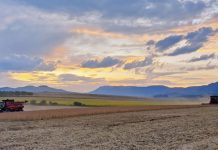
executive member,
Grain SA
The drying of soybeans in South Africa is not as common as in other parts of the world. This is despite the obvious advantages such as reduced harvest loss, more efficient use of harvesting equipment and a possible price advantage.
There are a few factors contributing to this situation, the main factor being (in the author’s opinion) that many of the drying and storage facilities in South Africa were erected in an era when mainly maize was grown. They were never adapted to be able to effectively dry and store soybeans, which resulted in a misconception that soybeans cannot be dried.
The main changes that are needed for drying soybeans are lower drying temperatures and higher airflow in the dryer as well as sufficient aeration of the storage silo.
South Africa’s unique conditions
In many cases, high volume aeration of the silo on its own already affords the ability to harvest at a higher moisture content. Especially in South Africa, low air humidity in the daytime is often experienced, making the aeration very effective in bringing down the moisture content of the harvested soybeans to safe storage levels.
South Africa’s climatic conditions during the soybean harvesting period are unique in that there is very high moisture due to dew at night and in the early morning, which increases the moisture of the soybean in the field. By noon, however, these conditions have swung around to very low air humidity and the grain on the field dries very quickly. This situation limits the time available to harvest the soybeans to a few hours a day.

At the same time this low air humidity situation actually lends itself to a unique opportunity to dry moist grain, which was harvested in the morning when the grain in the field was still moist, with only high volumes of air blown through the silo. By installing effective aeration in a silo the harvesting hours can, on most days, be nearly doubled. Caution must be given to spread the grain evenly in the silo so that the airflow reaches all the grain. Wet grain can be placed onto dry grain and vice versa in layers, as long as these layers are evenly distributed.
It must be noted, however, that this technique should preferably only be used for soybeans that are at a physiologically mature stage and where the high moisture content of the grain is only due to the moisture from dew or rain.

Harvesting earlier
If soybeans are to be harvested earlier (for example when there is an opportunity for a better price or to be able to plant a next crop quicker) a proper dryer is recommended, but some risks still have to be managed. The main problem with harvesting soybeans early in the season is immature pods on the plant or so-called ‘green pods’ that come into the grain during harvesting. The harvester needs to be constantly adjusted to remove as many of these pods as possible. These green pods can be dried in the dryer, but it requires a lot of energy. Once they are dry, they tend to shatter and the immature kernels which pop out are often deformed and green in colour and can result in the downgrading of the quality. The green pods also tend to accumulate in bunches in the silo. If they are not completely dry, they can rot and the rotting can spread to the adjacent grain.
A combination of a dryer and aeration in a silo can increase the efficacy of the drying process by discharging warm grain out of the dryer into the silo, leaving the warm grain for plus minus twelve hours in the silo and then cooling it down slowly. The moisture content will drop another two to three percent during the cooling process in the silo, instead of one to two percent if it was cooled down immediately in the dryer. This so called ‘dryeration’ process saves on drying time (because the cooling time is taken away from the dryer and moved to the silo) as well as energy (because the dryer needs to remove one percent less moisture).
Producers often say, when harvesting maize, that a grain cart can replace an extra combine harvester. Similarly a well-aerated silo can make the harvesting of soybeans more efficient.
For more information, contact Ralf Küsel at kuselfarming@gmail.com.


















